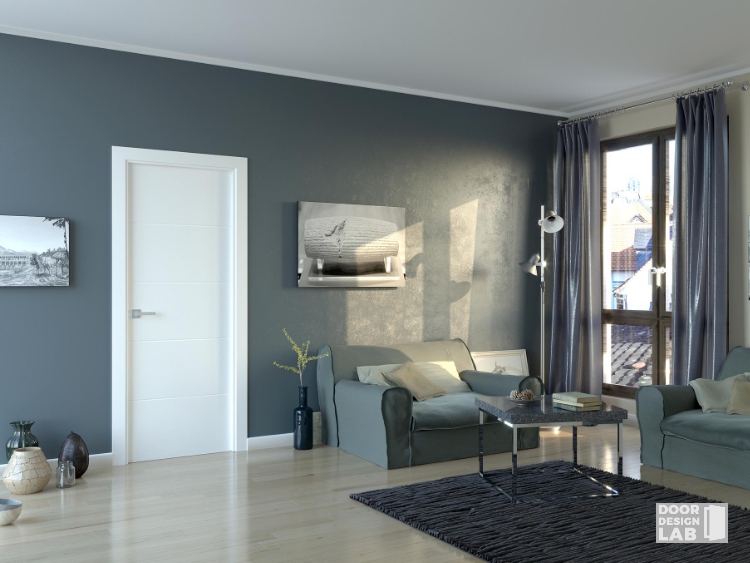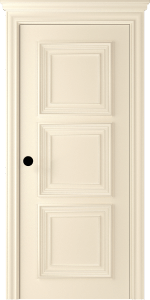
Contents
Choosing the correct type of door for your home is an important decision that can impact your living space's aesthetics and functionality. Two common types of doors that homeowners often consider are pre-hung doors and slab doors. While both options have advantages and disadvantages; the article describes the basic knowledge about the door types that will make it easier for you to make an informed decision.
What is a pre-hung door?
 A pre-hung door is a door that comes pre-assembled in a frame with hinges and a door jamb. The frame is designed to fit into a rough opening in the wall, making installation easier and quicker than with slab doors. The door frame also typically includes a threshold, making it a complete solution for exterior doors.
A pre-hung door is a door that comes pre-assembled in a frame with hinges and a door jamb. The frame is designed to fit into a rough opening in the wall, making installation easier and quicker than with slab doors. The door frame also typically includes a threshold, making it a complete solution for exterior doors.
The pre-hung door unit has five core parts:
- Frame.
- Slab with a pre-cut hole for the doorknob.
- Hinges.
- Mortises cut in the door.
When should you choose a pre-hung door?
Pre-hung doors are an excellent option for homeowners looking for a quick and easy installation process. Because the door is pre-assembled, there is less work involved in fitting it into the opening and attaching it to the wall.
A pre-hung door: pros and cons
Pros:
- Easier and quicker installation process.
- The process of installation is quite hassle-free.
- In case of exterior doors, they come with weatherstripping and a threshold for exterior doors, making it a complete solution.
- Hinges are pre-installed, ensuring proper alignment and reducing the risk of binding or sagging.
- You won't need to cut mortises.
- It comes with the necessary hardware.
- All you have to do is secure the parts in their right place.
If there is need for new construction work, a pre-hung door makes it quite convenient and fast.
Given that it comes with its frame, you can easily install it on the location that is open and exposed. People also choose pre-hung doors because there is no need to build the door frame from scratch. If you find that the existing door frame in your house is already damaged and it’ll be impossible to hang a slab, then it is best to have the entire door area demolished. In that case, you can easily start with a pre-hung door.
Pre-hung doors are also considered a good option for the exterior of the house. Exterior pre-hung doors are already weather-tight and there is no need for tight-fitting. If you are not very experienced, installing an insulated exterior slap door can be challenging. So, we’d recommend you to stick to a pre-hung exterior door.
Cons:
- They may be more expensive than slab doors due to the additional materials and labour involved in manufacturing and shipping pre-assembled doors.
- It may not be suitable for all door openings, especially if the rough opening is not a standard size.
- It may require adjustments to fit properly.
- It is much heavier than a slab door, so managing it alone is difficult.
A pre-hung door is quite expensive as compared to a slab door. In fact, you can save quite a bit of money if you decide to buy a slab door and other material. One of the main cons of a pre-hung door is that it is heavy and hard to manage. A pre-hung door is bulky and can weigh around 50 and 100 pounds. Although the installation of a pre-hung door is quite easy, you’d still have to make sure that it is correctly positioned and it means that there can be a need for a few adjustments.
Is it easier to install a pre-hung door?
Yes, pre-hung doors are generally easier to install than slab doors. Because the door is pre-assembled in a frame, there is less work involved in fitting it into the opening and attaching it to the wall. Additionally, the hinges are pre-installed, ensuring proper alignment and reducing the risk of binding or sagging.
What is a slab door?
 A slab door is a standalone door without a frame or hinges. This type of door requires more work to install as it must be hung on hinges and attached to a doorjamb or frame. Slab doors are available in various materials, including wood, metal, and fiberglass.
A slab door is a standalone door without a frame or hinges. This type of door requires more work to install as it must be hung on hinges and attached to a doorjamb or frame. Slab doors are available in various materials, including wood, metal, and fiberglass.
When should you choose a slab door?
Slab doors are an excellent option for homeowners looking for a wider range of customization options. Because slab doors do not come with a frame or hinges, they can be tailored to fit a wider range of door openings. Additionally, slab doors can be finished or painted to match the surrounding decor.
A slab door: pros and cons
Pros:
- It can be tailored to fit a wider range of door openings.
- You can install the slab into a used door frame.
- Available in a variety of materials, allowing for more customization options.
- Can be finished or painted to match the surrounding decor.
- They are lighter and easier to handle.
If saving money is one of your primary concerns, a slab door is a pretty good option. This door is not a bad option for an interior door because it gives more design flexibility and there is no issue of waterproofing. Although a slab door requires more time in installation as you need to create its frame, there is no denying that it gives you more freedom to be creative – something that a pre-hung door doesn’t give you.
Cons:
- It requires more work to install, including hanging the door on hinges and attaching it to a doorjamb or frame.
- It may not include weatherstripping or a threshold, making them less suitable for exterior doors where weather resistance is important.
- It may be more prone to binding or sagging if not properly installed.
Conclusion
In conclusion, both pre-hung and slab doors have advantages and disadvantages. Pre-hung doors are a great option for homeowners looking for a quick and easy installation process. In contrast, slab doors offer greater customization options. Ultimately, the decision between the two will depend on your specific needs and preferences. By understanding the differences between pre-hung doors and slab doors, you can make an informed decision.
Have Something to Ask?
You can check our collection of slab doors, and in case you have any questions then please feel free to contact us anytime. If you want to order pre-hung doors, use the door configurator that on every door page.

